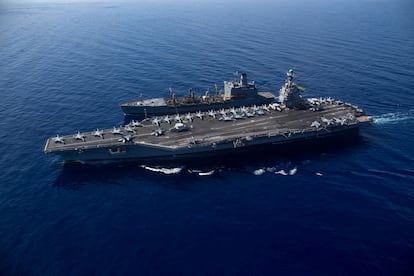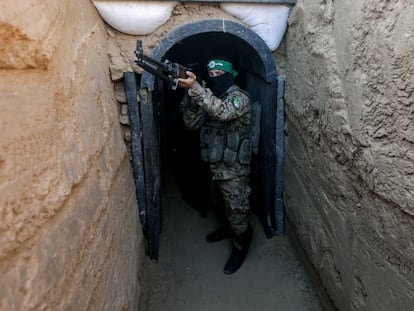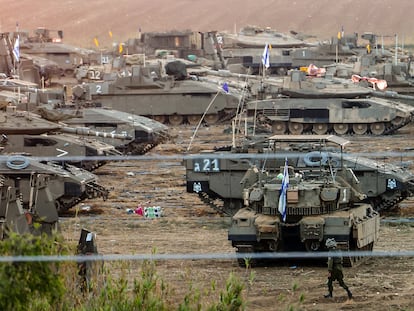Washington deploys carriers, Marines and combat aircraft to prevent escalation of Israel-Hamas conflict
The Pentagon has stressed that the arrival of warships in the region is not designed to engage in military action together with Israel: ‘There is no intention to put US boots on the ground in combat’


“My message to any state or any other hostile actor thinking about attacking Israel remains the same as it was a week ago: don’t, don’t, don’t,” said U.S. President Joe Biden on his visit to Tel Aviv on Wednesday. While calling for Israel’s containment and negotiating the entry of humanitarian aid into Gaza, Washington is steadily reinforcing its military presence in the eastern Mediterranean. Its objective is twofold: to dissuade Iran from intervening in the conflict between Israel and Hamas with an Israeli invasion of the Strip appearing imminent, but also to prepare to support its greatest ally in the region.
The U.S. deployment is forceful as the drums of war beat louder. Israeli Defense Minister Yoav Gallant has promised his troops that they will soon be able to see Gaza “from the inside” and drone attacks against American forces in the region are increasing. Washington’s most significant military gesture has been the dispatch of two aircraft carriers to the eastern Mediterranean, an extremely rare occurrence. The largest of its fleet, the USS Gerald R. Ford, and its escort ships are already present in the area. A second carrier, the USS Dwight D. Eisenhower, is on its way to the area, where it is expected within seven to 10 days. Between them, they are carrying up to 135 combat aircraft.
The Pentagon stresses that the carrier deployment is not designed to engage in military action together with Israel. Its mission is primarily to act as a deterrent in the face of the threat that Iran, the nemesis of Israel and the United States in the region, might be tempted to engage in hostile action that could aggravate the crisis or that the Islamic regime’s arm in southern Lebanon, the Hezbollah militia, might try to open a second front in the war with its attacks on northern Israel.
“There is no intention to put U.S. boots on the ground in combat,” National Security Council spokesman John Kirby stressed on the flight bringing Biden back to Washington after his less than eight-hour visit to Tel Aviv. “The point of the carriers is to deter anybody from taking action.”
Also headed for the eastern Mediterranean is the 2,200-strong 26th Marine Expeditionary Unit and a three-ship amphibious group. Two of them, the USS Bataan and the USS Carter Hall, are in the Gulf of Aden. The third, the USS Mesa Verde, is in the Mediterranean after undergoing repairs in Spain. The Bataan can carry helicopters and Osprey and Harrier vertical takeoff aircraft.
Also in the area is the U.S. warship Mount Whitney, on which the commander of the Sixth Fleet, Vice Admiral Thomas Ishee, is based, the U.S. Navy has announced. This command ship, with a crew of 300, has the capability to receive, process and transmit “large amounts of data from anywhere on Earth” in complete safety, according to the Pentagon.
Meanwhile, the Defense Department confirmed earlier this week that it has ordered 2,000 soldiers from various units to prepare to be ready to move to the Middle East within 24 hours, rather than the usual 96 hours. These military personnel are specialized in tasks ranging from air defense to logistics to medical assistance and terrain reconnaissance.
In addition, the Department of Defense has also reinforced its air power in the region with warplanes including F-35 fighters, F-16s and A-10 Thunderbolt subsonic attack aircraft.
A $10 billion package
Assistance to Israel is not limited to sending a military deployment to the area. From the outset of the crisis, Washington has accelerated the delivery of military equipment to its ally, with which it has a defense assistance agreement worth more than $3 billion a year through 2028. It has already moved at least two shipments including ammunition and air defense to Israel; U.S. Secretary of Defense Lloyd Austin visited an air base in Israel last week to witness the arrival of the second shipment. “Our security assistance continues to flow, including munitions, to meet Israel’s urgent needs,” Pentagon Deputy Press Secretary Sabrina Singh said at a press briefing this week.
The White House plans to ask Congress to approve a foreign aid appropriation of nearly $100 billion, of which $10 billion would be designated for military aid to Israel and $60 billion for Ukraine, according to U.S. media.
“The department remains focused on three objectives — supporting Israel’s defense through security assistance, sending a strong signal […] of deterrence to any actors who might be thinking of entering the conflict, and staying vigilant to any threats to U.S. forces in the region,” Singh added.
A “sufficient and credible” military force
“Obviously, we have national security interests. We’ll protect them if we need to,” Kirby stressed. “It’s a sufficient, credible military force, and if as Commander-in-Chief, [Biden] decides that that force needs to be used to defend our interests, we’ll do that.”
With tensions at an all-time high following Tuesday’s explosion at a Gaza hospital — which Hamas blames on Israel and Israel blames on Islamic Jihad, the Strip’s second-largest militia — U.S. military forces in the region are on high alert for possible attacks by Iranian-backed groups.
In Syria, U.S. forces shot down two drones preparing to attack them, the Defense Department said Thursday. In Iraq, U.S. bases were hit by drones earlier this week in an incident that resulted in “minor injuries to Coalition forces,” the U.S. Central Command said in a statement. “In this moment of heightened alert, we are vigilantly monitoring the situation in Iraq and the region. We want to emphasize U.S. forces will defend U.S. and Coalition forces against any threat.”
On Thursday, the destroyer USS Carney, in waters north of the Red Sea, shot down three cruise missiles and several drones launched by Houthi rebels in Yemen, in an attack that could have been targeting Israel, according to Pentagon spokesman General Pat Ryder.
U.S. troops are also engaged in peacekeeping activities. In an unannounced visit, General Michael Erik Kurilla, head of Central Command and responsible for U.S. forces in the Middle East, met in person with Egyptian President Abdel-Fattah el-Sisi. They discussed the situation in Gaza and how to send the humanitarian aid waiting at the Rafah border crossing — which connects the strip with the Egyptian Sinai and is the only access to Gaza not controlled by Israel — into the Strip.
Sign up for our weekly newsletter to get more English-language news coverage from EL PAÍS USA Edition
Tu suscripción se está usando en otro dispositivo
¿Quieres añadir otro usuario a tu suscripción?
Si continúas leyendo en este dispositivo, no se podrá leer en el otro.
FlechaTu suscripción se está usando en otro dispositivo y solo puedes acceder a EL PAÍS desde un dispositivo a la vez.
Si quieres compartir tu cuenta, cambia tu suscripción a la modalidad Premium, así podrás añadir otro usuario. Cada uno accederá con su propia cuenta de email, lo que os permitirá personalizar vuestra experiencia en EL PAÍS.
¿Tienes una suscripción de empresa? Accede aquí para contratar más cuentas.
En el caso de no saber quién está usando tu cuenta, te recomendamos cambiar tu contraseña aquí.
Si decides continuar compartiendo tu cuenta, este mensaje se mostrará en tu dispositivo y en el de la otra persona que está usando tu cuenta de forma indefinida, afectando a tu experiencia de lectura. Puedes consultar aquí los términos y condiciones de la suscripción digital.
More information
Archived In
Últimas noticias
Most viewed
- David King, chemist: ‘There are scientists studying how to cool the planet; nobody should stop these experiments from happening’
- Reinhard Genzel, Nobel laureate in physics: ‘One-minute videos will never give you the truth’
- Mexico completes its trade shift with the entry into force of tariffs on China and countries without trade agreements
- Oona Chaplin: ‘I told James Cameron that I was living in a treehouse and starting a permaculture project with a friend’
- Sinaloa Cartel war is taking its toll on Los Chapitos










































